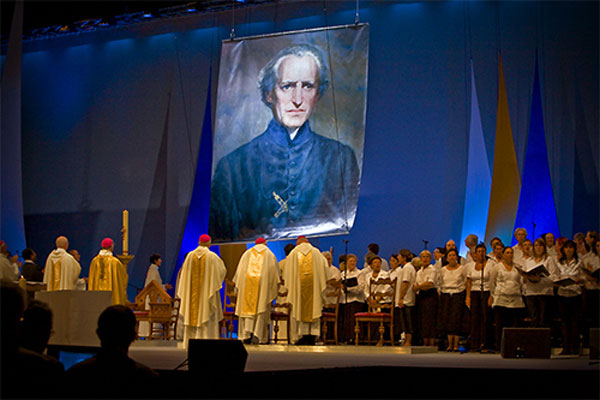1) What does the spirituality of Bl. Basil Moreau offer for the Christian looking to keep Lent?
The spirituality of Basil Moreau offers a bold, vivid, and practical program for the renewal and reordering of one’s life on the journey of discipleship. The Lenten practices of prayer, fasting, and almsgiving, like the Christian life itself, are ultimately aimed at re-integrating and renewing our memory, intellect, and will in conformity with Jesus Christ. The Spiritual Exercises offer us a plan for such renewal. Like the Exercises of St. Ignatius, they are a sort of itinerary of conversion. Basil encourages the exercitant (the one making the exercises) to “put off the old self” and to “put on the new self” of Christ.
The centerpiece of Basil’s spirituality is this conformity to Christ, and conformity to his Paschal Mystery in particular: a project that begins in baptism and ends only in resurrection (Gawrych & Grove, eds., Basil Moreau: Essential Writings: 45). Christianity, for Moreau, is nothing more and nothing less than Christ’s life reproduced in each Christian. Thus the end goal of the spiritual life is, in Basil’s words, to be “alive with the very life of Jesus” (Week II, day 1). The conformity which Basil envisions is so transformative and complete that the Christian become “truly another Jesus Christ” (Week II, day 1).
The Spiritual Exercises aid disciples along this path toward conformity to Christ by offering a series of meditations that are at once life-giving, profound, luminous, and practical. Their goal is ultimately to help those engaged in them to know, love, imitate, and thereby become Christ.
2) We all know the Spiritual Exercises of Ignatius of Loyola. What is distinct about Bl. Basil Moreau's?
Basil’s Exercises are modeled after those of Ignatius. So one will notice many similarities: their method, their four-week (30 day) structure, and even some of their specific content. The major innovation of Basil’s Exercises, however, is that they are written directly for the retreatant. Ignatius wrote his Exercises for the use of the retreat director, and they feel very much like a manual when you read them. An individual meditation will often require the reader to cross-reference previous meditations which results and quite a bit of page-flipping. Basil’s meditations are a bit more user-friendly (as they are intended to be) insofar as each meditation stands alone textually.
Basil’s Exercises are also known to be more detailed and descriptive than those of Ignatius. He takes the basic Ignatian structure and fills it in with more imagery, reflections, and “stage directions” to guide one’s meditation. For example, Ignatius makes a claim at the beginning of his Exercises called the principle and foundation: “Human beings are created to praise, reverence, and serve God our Lord, and by means of this save their souls.” Basil takes this fundamental assertion and develops it into an entire meditation which contains this famous passage:
[My Creator] necessarily had in mind his own glory and not that of another when he brought me forth from nothingness. And so, if he has given me a mind, it is for knowing him; if he has given me a heart free to love, it is for clinging to him; if he has given me limbs and health and strength, it is for using them to serve him. If then I am everything that I in fact am, it can only be all for him; and I need constantly to turn to him as to the center of my life (Week I, day 2).
There are many more examples like this that highlight some of the major stylistic differences between Basil and Ignatius. Basil also wrote two more volumes of Exercises which revolve around the Sundays and major feast days of the liturgical year. So Basil offers some material which Ignatius does not.
3) What is involved in practicing these exercises beside attending the weekly talks?
The weekly talks are intended to facilitate an integrative discipleship. They consist of a brief reflection from members of the local community familiar with Moreau’s thought and spirituality, followed by a period of silent prayer using each week’s particular meditation. The rest of the time is used for small group discussion and faith-sharing, and the hour concludes with a closing prayer and informal socializing (food provided!). We hope that the structure of these Friday meditations inform and strengthen our discipleship for the rest of the week and beyond.
Outside of the regular meetings, we encourage our participants to pray with the meditation again and allow it to sink in more deeply. Ignatius instructs his retreatants to spend an hour (or more) with each Spiritual Exercise. We don’t have quite enough time in our weekly meetings to dedicate an entire hour to silent prayer, but the participants often benefit from a longer, private encounter with the meditation.
Practicing these exercises also involves remembering the insights and resolutions that we reach in our prayer. Each of Basil’s meditations concludes with a concrete resolution to reform my life in some way or other. As we mentioned above, these Exercises are very practical and concrete. The hope is that our participants try to put their resolutions into practice as they leave to return to their friends, residence halls, families, work, and classes.

